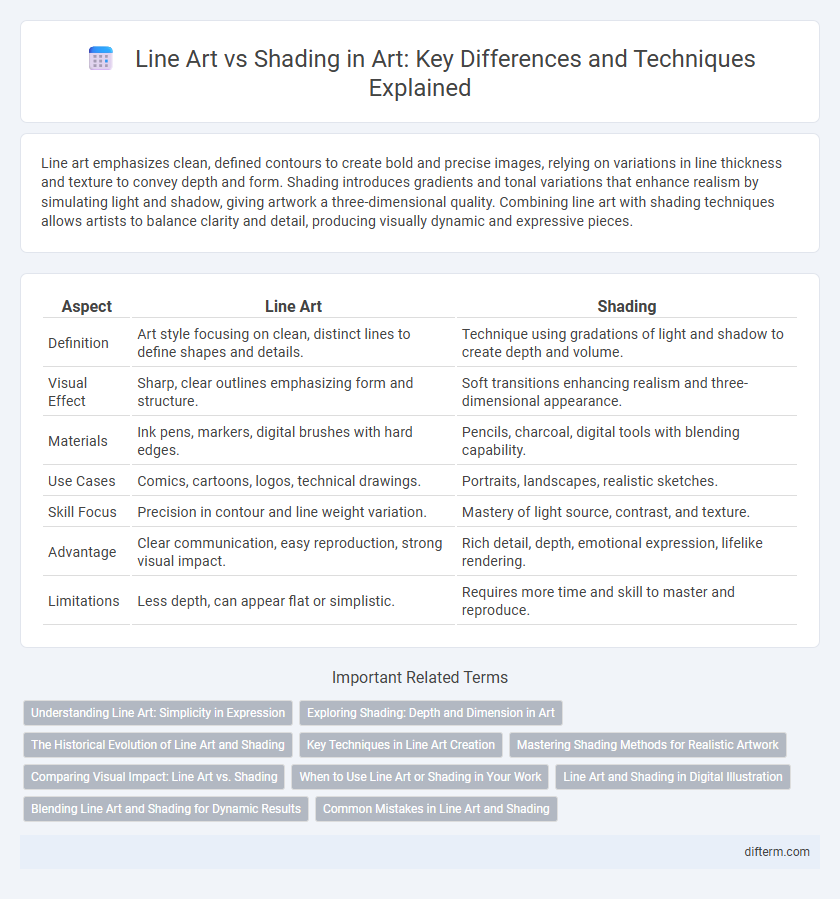Line art emphasizes clean, defined contours to create bold and precise images, relying on variations in line thickness and texture to convey depth and form. Shading introduces gradients and tonal variations that enhance realism by simulating light and shadow, giving artwork a three-dimensional quality. Combining line art with shading techniques allows artists to balance clarity and detail, producing visually dynamic and expressive pieces.
Table of Comparison
| Aspect | Line Art | Shading |
|---|---|---|
| Definition | Art style focusing on clean, distinct lines to define shapes and details. | Technique using gradations of light and shadow to create depth and volume. |
| Visual Effect | Sharp, clear outlines emphasizing form and structure. | Soft transitions enhancing realism and three-dimensional appearance. |
| Materials | Ink pens, markers, digital brushes with hard edges. | Pencils, charcoal, digital tools with blending capability. |
| Use Cases | Comics, cartoons, logos, technical drawings. | Portraits, landscapes, realistic sketches. |
| Skill Focus | Precision in contour and line weight variation. | Mastery of light source, contrast, and texture. |
| Advantage | Clear communication, easy reproduction, strong visual impact. | Rich detail, depth, emotional expression, lifelike rendering. |
| Limitations | Less depth, can appear flat or simplistic. | Requires more time and skill to master and reproduce. |
Understanding Line Art: Simplicity in Expression
Line art emphasizes clarity and simplicity through bold, distinct outlines, capturing the essence of a subject without relying on tonal variations. Unlike shading, which adds depth and texture by manipulating light and shadow, line art focuses on form and structure with minimalistic precision. Mastery of line art enhances an artist's ability to convey emotion and detail efficiently, making it a foundational skill in various art styles such as comics, illustrations, and design.
Exploring Shading: Depth and Dimension in Art
Shading techniques enrich line art by adding depth and dimension, transforming flat sketches into dynamic visual experiences. By manipulating light and shadow through gradients, hatching, and cross-hatching, artists create realistic textures and volume, enhancing the perception of three-dimensionality. Mastering shading improves the overall impact of artwork by emphasizing contours and spatial relationships within the composition.
The Historical Evolution of Line Art and Shading
Line art originated in ancient civilizations with simple contour drawings, evolving through the Renaissance where artists like Leonardo da Vinci emphasized precise outlines to define form. Shading techniques advanced significantly during the Baroque period, introducing chiaroscuro to create depth and realism by manipulating light and shadow. The 20th century saw both methods blend in modern and digital art, highlighting the continuous interplay between linear precision and tonal gradation in visual storytelling.
Key Techniques in Line Art Creation
Key techniques in line art creation include controlling line weight to convey depth and emphasis, using varied stroke types such as hatching or cross-hatching to suggest texture, and maintaining clean, deliberate outlines to define form sharply. Precision in line placement ensures clarity and composition balance, while consistency in style enhances visual coherence. Mastery of these techniques distinguishes effective line art, allowing artists to communicate intricate details without relying on shading.
Mastering Shading Methods for Realistic Artwork
Mastering shading methods enhances line art by adding depth, dimension, and realism to artwork. Techniques such as hatching, cross-hatching, stippling, and smooth gradients create subtle variations in light and shadow, elevating flat line drawings into lifelike compositions. Understanding light source, shadow placement, and tonal contrast is crucial for artists aiming to produce realistic and captivating images.
Comparing Visual Impact: Line Art vs. Shading
Line art emphasizes clean, bold outlines that create a striking and simplified visual impact, often highlighting form and structure with minimal detail. Shading introduces gradients and tonal variation, enhancing depth, volume, and realism in the artwork by simulating light and shadow. The choice between line art and shading significantly affects the viewer's perception, where line art conveys clarity and stylization, while shading evokes texture and three-dimensionality.
When to Use Line Art or Shading in Your Work
Line art excels in creating clear, defined shapes and is ideal for illustrations requiring simplicity and strong contrast, such as comic books or technical drawings. Shading enhances depth, texture, and realism, making it perfect for portraits and detailed landscapes where volume and light interplay are essential. Choosing between line art and shading depends on the desired visual impact, with line art emphasizing form and clarity, and shading emphasizing dimension and mood.
Line Art and Shading in Digital Illustration
Line art in digital illustration emphasizes clean, crisp outlines that define shapes and details, serving as the foundational structure for artworks. Shading adds depth and dimension by varying light and shadow, enhancing realism and texture in the composition. Combining precise line art with dynamic shading techniques creates visually compelling digital illustrations that balance clarity and complexity.
Blending Line Art and Shading for Dynamic Results
Blending line art with shading enhances depth and dimension, creating dynamic visual effects that bring illustrations to life. Utilizing varied line weights combined with gradient shading techniques adds texture and contrast, emphasizing form and movement. Mastery of this integration is essential for artists aiming to produce compelling, expressive artworks.
Common Mistakes in Line Art and Shading
Common mistakes in line art include inconsistent line weight, which weakens depth perception, and shaky or uneven lines that disrupt the artwork's clarity. In shading, artists often apply improper light source understanding, resulting in flat or unrealistic shadows that lack gradient variation. Both errors hinder the overall dimensionality and visual impact of the piece.
line art vs shading Infographic

 difterm.com
difterm.com